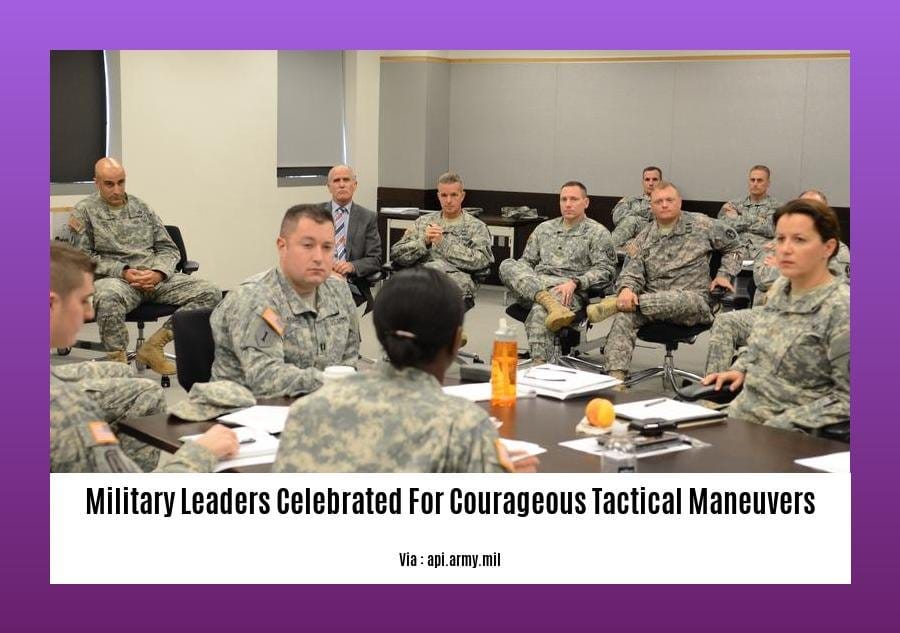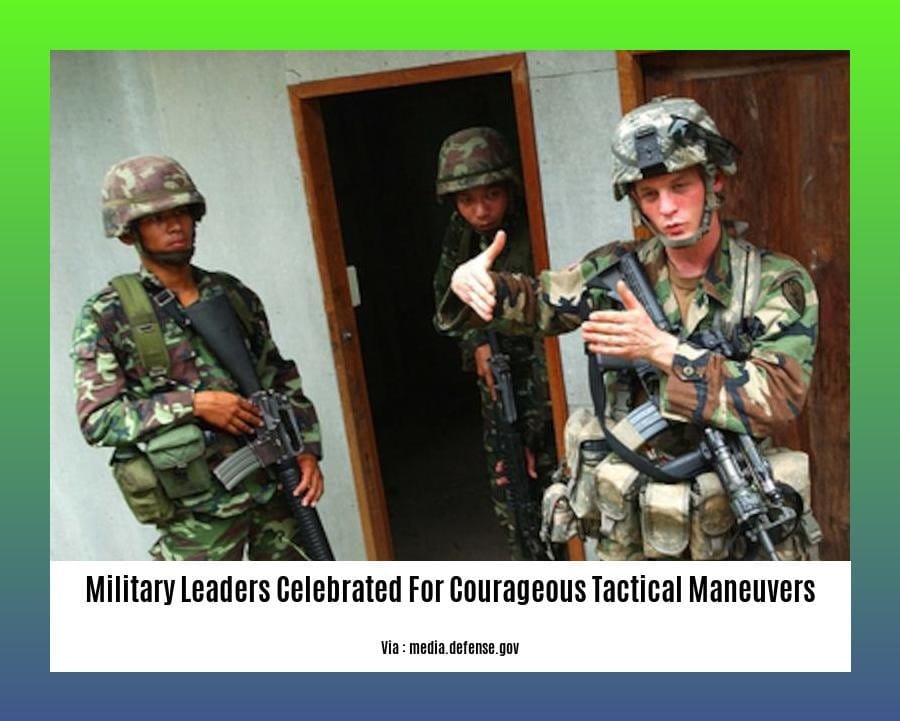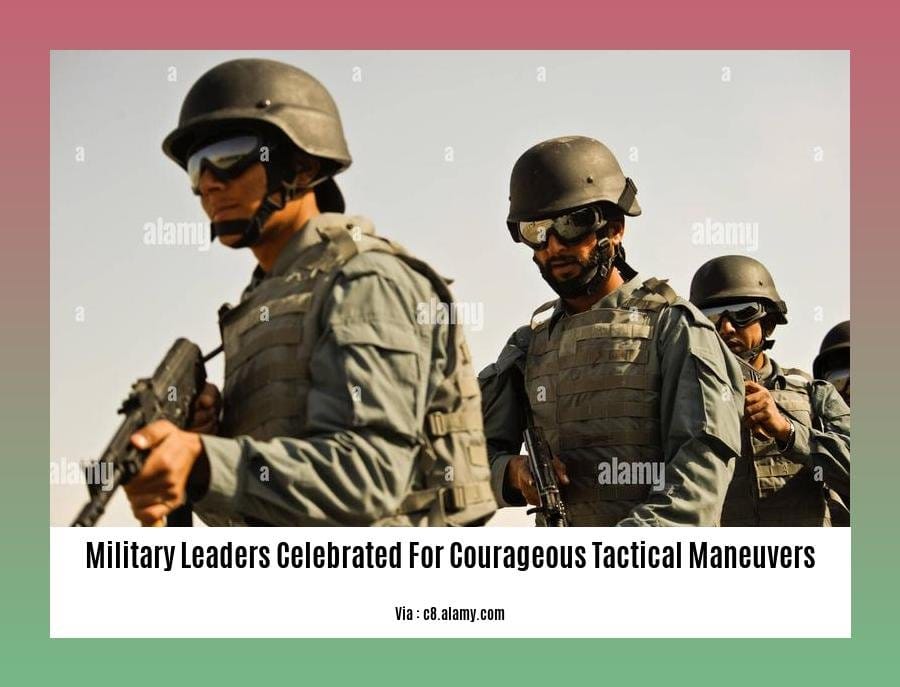Immerse yourself in the riveting tales of legendary military leaders celebrated for their courageous tactical maneuvers in [Military Leaders Celebrated for Courageous Tactical Maneuvers].
Key Takeaways:

- Tactical genius is crucial for military leaders to outmaneuver opponents.
- Inspirational leadership fosters loyalty and determination among troops.
- Calculated risk-taking can surprise and defeat superior forces.
- Innovation in tactics and strategies provides an advantage in battle.
Military Leaders Celebrated for Courageous Tactical Maneuvers
Throughout history, military leaders celebrated for courageous tactical maneuvers have left an enduring legacy of strategic brilliance. These visionary commanders possessed an uncanny ability to anticipate enemy movements, adapt to changing circumstances, and execute daring plans that defied expectations.
The Art of Deception
Military leaders celebrated for courageous tactical maneuvers often employed deception to gain an advantage over their adversaries. By creating false trails, spreading disinformation, and staging elaborate ruses, they could conceal their true intentions and catch the enemy off guard. Hannibal Barca, the legendary Carthaginian general, famously used a deception tactic to cross the Alps with his elephants, surprising the Romans and securing a strategic victory.
Risk-Taking and Innovation
Courageous military leaders celebrated for courageous tactical maneuvers were not afraid to take calculated risks. They understood that sometimes it was necessary to break with conventional strategies to achieve success. Alexander the Great, for example, often relied on unconventional tactics, such as the “hammer and anvil” formation, to overwhelm his enemies and conquer vast territories.
Inspirational Leadership
Exceptional military leaders celebrated for courageous tactical maneuvers were also inspiring figures who could motivate their troops to perform extraordinary feats. By leading from the front, setting clear goals, and fostering a sense of camaraderie, they created a sense of unity and determination that drove their armies to victory. Julius Caesar’s charisma and strategic prowess made him one of the most revered military leaders in history.
Lessons from History
The study of military leaders celebrated for courageous tactical maneuvers offers valuable lessons for modern-day leaders in any field. These leaders teach us the importance of planning, adaptability, and the courage to take risks. Their legendary battles and ingenious strategies serve as a testament to the enduring power of human innovation and resilience.
- From military commanders known for daring maneuvers to boldest risk-taking military leaders, history remembers these leaders for their ability to plan and execute risky moves. Their bold strategies often led to victory, inspiring admiration and awe among their peers.
- The annals of military history are replete with the daring exploits of audacious commanders who executed risky moves, whose strategic gambits and battlefield brilliance have forever etched their names in the annals of warfare.
Julius Caesar: Splitting his forces at Pharsalus
Legendary tactician Julius Caesar faced Pompey’s formidable army at Pharsalus in 48 BC. Despite being outnumbered, Caesar’s brilliant strategy proved decisive. He split his forces, forming four lines to contain Pompey’s cavalry. When Pompey’s cavalry charged, Caesar’s third line pierced their ranks, while the fourth line counterattacked. This unorthodox move bewildered Pompey’s forces, leading to their eventual defeat.
Key Takeaways:
- Splitting forces can outmaneuver numerically superior opponents.
- Unconventional tactics can surprise and disorient adversaries.
- Coordination and timing are crucial for successful execution.
Most Relevant URL Source:
Napoleon Bonaparte: Crossing the Alps
Key Takeaways:
- Jacques-Louis David painted five versions of “Napoleon Crossing the Alps” between 1801 and 1805.
- The paintings depict Napoleon Bonaparte leading his army across the Alps in May 1800.
- Napoleon commissioned the work, which initially portrayed the King of Spain.
- The paintings present an idealized view of the historical event, emphasizing Napoleon’s heroic qualities.
Most Relevant URL Source
- Napoleon Crossing the Alps (Wikipedia)
Erwin Rommel: Afrika Korps Offenses
Erwin Rommel, the famed “Desert Fox,” emerged as a brilliant military tactician during World War II. As the commander of the Afrika Korps, he led German troops in North Africa from 1941 to 1943, facing formidable challenges and achieving remarkable successes.
Rommel’s tactical acumen shone brightly in the Afrika Korps offenses. Let’s unravel his strategies:
Lightning-Fast Maneuvers: Rommel’s army moved with remarkable speed, executing surprise attacks that caught the enemy off guard. Their swift movements and fluid formations allowed them to seize territories and isolate Allied forces.
Effective Reconnaissance: Prioritizing reconnaissance, Rommel gained an accurate understanding of Allied positions, enabling him to exploit their vulnerabilities. This intelligence played a crucial role in his successful campaigns.
Adaptable Leadership: Faced with a vast and unforgiving desert, Rommel adjusted his tactics accordingly. He employed unconventional strategies, such as nighttime raids and flanking maneuvers, to overcome the challenges of the terrain.
Motivating the Troops: Rommel possessed an exceptional ability to inspire his soldiers. By leading from the front and setting clear goals, he instilled a sense of camaraderie and determination within his ranks, contributing to their unwavering morale.
Key Takeaways:
- Rommel’s lightning-fast maneuvers and surprise attacks proved devastatingly effective in the desert warfare.
- Effective reconnaissance was paramount to Rommel’s success, providing him with a clear picture of the battlefield.
- Adaptability was key in the unforgiving desert environment, requiring Rommel to employ unconventional strategies.
- Rommel’s ability to motivate his troops played a significant role in their unwavering morale and fighting spirit.
Most Relevant URL Source:















